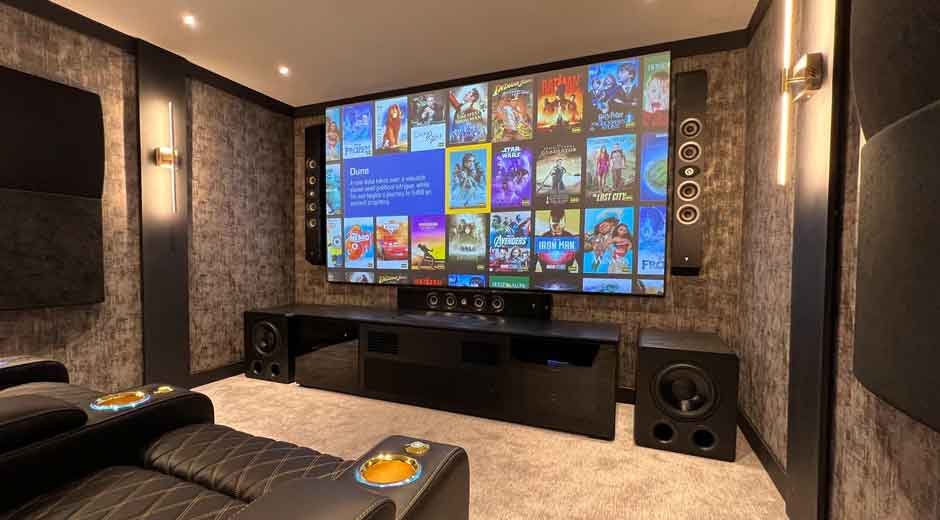Creating a home theater in a small space presents unique challenges and opportunities that require thoughtful planning and strategic design choices. While limited square footage can seem restrictive, it also encourages creativity, efficiency, and a focus on functionality without compromising the immersive entertainment experience. By carefully considering layout, seating, acoustics, and technology, homeowners can transform compact rooms into cinematic environments that rival larger setups.
We will explore how to maximize the potential of smaller areas, ensuring comfort, optimal sound quality, and visual appeal while maintaining an inviting and stylish atmosphere. If you are looking for home theater installation near you, even a modest room can become a destination for family gatherings, movie nights, and gaming sessions. Every design decision, from furniture selection to lighting and speaker placement, plays a crucial role in achieving a balanced and enjoyable space that delivers both performance and aesthetic appeal.
Practical Strategies for Small Space Home Theaters
- Optimize Room Layout and Seating
The foundation of a successful small-space home theater begins with the arrangement of the room and seating. Prioritizing the viewing area ensures that every seat provides a clear sightline to the screen. In compact rooms, consider using wall-mounted screens or projectors to save floor space. Tiered seating may be impractical, but carefully placed sofas, recliners, or even built-in benches can maximize seating without overcrowding. Compact, multi-functional furniture can also help maintain a sense of openness.
Ensure pathways are unobstructed for ease of movement, and experiment with seating angles to create an immersive viewing experience without requiring a large footprint. Selecting furniture with a low profile and neutral tones can visually expand the space while keeping focus on the screen. Every inch counts in a small room, so strategic planning of each seating element is essential for comfort and functionality.
- Lighting Considerations and Control
Lighting plays a crucial role in enhancing the ambiance of a home theater, particularly in smaller spaces. Adjustable lighting options such as dimmable overhead lights, wall sconces, or LED strips allow for control over brightness and mood. Avoid harsh or direct lighting on the screen to prevent glare and distractions. Blackout curtains or shades are essential in rooms with windows, ensuring that external light does not interfere with viewing. Layered lighting techniques, such as indirect lighting positioned behind the screen or along the floor, can create depth without overwhelming the room. Additionally, lighting can be integrated with smart home systems, allowing users to adjust settings with a single device. Proper lighting enhances the cinematic experience, highlighting the room’s design while maintaining a cozy and immersive atmosphere that suits a small space.
- Acoustic Management
Sound quality is often the defining factor of a home theater experience, and small spaces require careful acoustic planning. Walls and ceilings in compact rooms can create unwanted echoes or sound reflections, which can disrupt the clarity of sound. Using acoustic panels, thick rugs, and heavy curtains helps absorb excess sound and improve audio quality. Consider speaker placement to balance sound throughout the room, avoiding corners where bass can become distorted. Subwoofers should be positioned to prevent overwhelming low frequencies. Wall-mounted or ceiling speakers can free up space while maintaining sound coverage. Even small adjustments, such as angling speakers slightly or adding sound diffusers, can dramatically enhance the auditory experience. Proper acoustic planning ensures that a compact home theater delivers rich, immersive sound without requiring additional square footage or cumbersome equipment.
- Screen Selection and Placement
Choosing the right screen size and positioning it correctly is crucial for a small-space home theater. Oversized screens can overwhelm a limited area, causing discomfort and reducing image quality. Measure the distance from the seating area to determine the optimal screen size, striking a balance between immersion and comfort. Wall-mounted screens or retractable projector screens save space while providing flexibility for different activities. Ensure the screen height aligns with the natural line of sight from the primary seating area. Matte finishes or anti-glare options may further improve viewing quality in spaces where light control is limited. By selecting a screen thoughtfully, homeowners can create a theater-like experience that fits seamlessly into a smaller room, making every viewing session comfortable, visually striking, and highly engaging.
- Technology Integration and Cable Management
Efficient technology integration is essential in compact home theaters to avoid clutter and maintain a clean, functional design. Wireless solutions for audio and streaming can reduce the number of visible cables, while cable management systems keep wires organized and out of sight. Mounting components on walls or inside cabinets maximizes floor space and reduces visual distractions. Select equipment that strikes a balance between performance and size, ensuring that even compact devices deliver high-quality video and audio. Smart home control systems can further streamline operation, allowing users to manage lighting, audio, and video from a single interface. Prioritizing organization and integration ensures that technology enhances the cinematic experience without making the room feel cramped or cluttered.
Designing a home theater in a small space requires thoughtful planning, creativity, and careful attention to detail. By optimizing layout, seating, lighting, acoustics, screen placement, technology, décor, and ventilation, homeowners can transform even modest rooms into immersive entertainment areas. Small spaces encourage efficient use of every square foot, resulting in functional, stylish, and enjoyable environments. With strategic design choices, a compact home theater can deliver high-quality visuals, balanced sound, and a comfortable atmosphere, providing an exceptional viewing experience for family and friends. Even limited areas can become cinematic destinations, proving that size does not determine the quality of entertainment.










